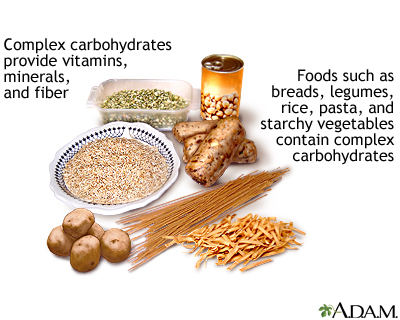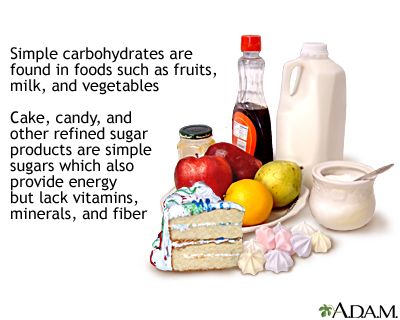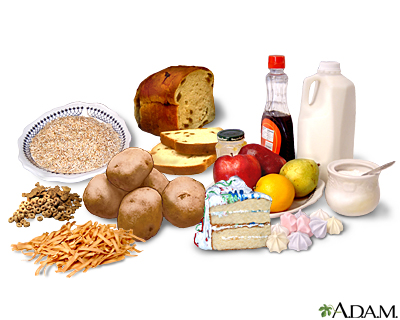Carbohydrates
Starches; Simple sugars; Sugars; Complex carbohydrates; Diet - carbohydrates; Simple carbohydrates
Carbohydrates are one of the main nutrients in our diet. They help provide energy for our body. There are three main types of carbohydrates found in foods: sugars, starches, and fiber.
People with diabetes often need to count the amount of carbohydrates they eat to ensure a consistent supply throughout the day as well as to help choose mealtime doses of insulin.
Images



Function
Your body needs all three forms of carbohydrates to function properly.
Sugars and most starches are broken down by the body into glucose, which then circulates in the blood to be used as energy.
Fiber is the part of food that is not broken down by the body. There are two types of fiber. Insoluble fiber adds bulk to your stools so you stay regular. Soluble fiber helps lower cholesterol levels and can help improve blood glucose control. Both types of fiber can help you to feel full and stay at a healthy weight.
Food Sources
Many foods contain one or more types of carbohydrates.
SUGARS
Sugars, or simple carbohydrates, occur naturally in these nutrient-rich foods:
- Fruits
- Milk and milk products
Some foods have added sugar. Many packaged and refined foods contain added sugar. These include:
- Candy
- Cookies, cakes, and pastries
- Regular (non-diet) carbonated beverages, such as soda
- Heavy syrups, such as those added to canned fruit
Refined grains with added sugar provide calories, but they lack vitamins, minerals, and fiber. Because they lack nutrients, these foods provide "empty calories" and can lead to weight gain. Try to minimize your intake of foods with added sugars.
STARCHES
Starches are also called complex carbohydrates. These nutrient-rich foods are high in starch (many are also high in fiber):
- Canned and dried beans, such as kidney beans, black beans, pinto beans, black-eyed peas, split peas, and garbanzo beans
- Starchy vegetables, such as potatoes, corn, green peas, and parsnips
- Whole grains, such as brown rice, oats, barley, and quinoa
Refined grains, such as those found in pastries, white bread, crackers, and white rice also contain starch. However, they lack B vitamins and other important nutrients unless they are marked "enriched." Foods made with refined or "white" flour also contain less fiber and protein than whole-grain products and do not help you feel as satisfied.
FIBER
High-fiber foods include:
- Whole grains, such as whole wheat and brown rice as well as whole-grain breads, cereals, and crackers
- Beans and legumes, such as black beans, kidney beans, and garbanzo beans
- Vegetables, such as broccoli, Brussels sprouts, corn, and potato with the skin
- Fruits, such as raspberries, pears, apples, and figs
- Nuts and seeds
Most processed and refined foods, enriched or not, are low in fiber.
Side Effects
Eating too many carbohydrates in the form of processed, starchy, or sugary foods can increase your total calorie intake, which can lead to weight gain. It can also lead you to not consume enough fat and protein.
Severely restricting carbohydrates can cause ketosis. This is when the body uses fat for energy because there are not enough carbohydrates from food for the body to use for energy.
Recommendations
It is best to get most of your carbohydrates from whole grains, dairy, fruits, and vegetables rather than refined grains. In addition to calories, whole grain foods provide vitamins, minerals, and fiber.
By making smart food choices, you can get the full range of healthy carbohydrates and plenty of nutrients:
- Choose a variety of foods including whole grains, fruits and vegetables, beans and legumes, and low-fat or non-fat dairy products.
- Read labels on canned, packaged, and frozen foods to avoid added sugar, salt, and fat.
- Make at least half of your grain servings per day from whole grains.
- Choose whole fruits and 100% fruit juices with no added sugar. Make at least half of your daily fruit servings from whole fruits.
- Limit sweets, sugar-sweetened beverages, and alcohol. Limit added sugars to less than 10 percent of your calories per day.
Here is what is considered "1 serving" of carbohydrate-rich foods according to the USDA (www.myplate.gov):
- Starchy vegetables: 1 cup (230 grams) mashed potato or sweet potato, 1 small ear of corn.
- Fruits: 1 medium-sized fruit (such as an apple or orange), ½ cup dried fruit (95 grams) 1 cup 100% fruit juice (240 milliliters), 1 cup berries (or about 8 large strawberries).
- Breads and cereals, grains, and beans: 1 slice of whole-grain bread; 1/2 cup (100 grams) of cooked brown rice, pasta, or cereal; 1/4 cup cooked peas, lentils, or beans (50 grams), 3 cups popped popcorn (30 grams).
- Dairy: 1 cup (240 milliliters) of skim or low-fat milk or 8 ounces (225 grams) plain yogurt.
The food guide plate recommends filling half of your plate with fruits and vegetables, and one-quarter of your plate with grains, at least half of which are whole grains.
Here is a sample 2,000-calorie menu with healthy carbohydrate choices:
BREAKFAST
- 1 cup (60 grams) shredded wheat cereal, topped with 1 tbsp (10 grams) raisins and one cup (240 milliliters) fat-free milk
- 1 small banana
- 1 hard-boiled egg
LUNCH
Smoked turkey sandwich, made with 2 ounces (55 grams) whole-wheat pita bread, 1/4 cup (12 grams) romaine lettuce, 2 tomato slices, 3 ounces (85 grams) sliced smoked turkey breast.
- 1 teaspoon (tsp) or 5 milliliters (mL) mayonnaise-type salad dressing
- 1 tsp (2 grams) yellow mustard
- 1 medium pear
- 1 cup (240 milliliters) tomato juice
DINNER
- 5 ounces (140 grams) grilled top loin steak
- 3/4 cup (190 grams) mashed sweet potato
- 2 tsp (10 grams) soft margarine
- 1 cup (30 grams) spinach salad
- 2 ounce (55 grams) whole-wheat dinner roll
- 1 tsp (5 grams) soft margarine
- 1 cup (240 milliliters) fat-free milk
- 1 cup (240 milliliters) unsweetened applesauce
SNACK
- 1 cup (225 grams) low-fat plain yogurt with strawberries on top
Related Information
FiberReferences
Baynes JW. Carbohydrates and lipids. In: Baynes JW, Dominiczak MH, eds. Medical Biochemistry. 6th ed. Philadelphia, PA: Elsevier; 2023:chap 3.
Bhutia YD, Ganapathy V. Digestion and absorption of carbohydrate, protein, and fat. In: Feldman M, Friedman LS, Brandt LJ, eds. Sleisenger and Fordtran's Gastrointestinal and Liver Disease. 11th ed. Philadelphia, PA: Elsevier; 2021:chap 102.
Saint-Cyr M, Waldrop SW, Krebs NF. Nutritional requirements. In: Kliegman RM, St. Geme JW, Blum NJ, et al, eds, Nelson Textbook of Pediatrics. 22nd ed. Philadelphia, PA: Elsevier; 2025:chap 60.
Snetselaar LG, de Jesus JM, DeSilva DM, Stoody EE. Dietary guidelines for Americans, 2020-2025: understanding the scientific process, guidelines, and key recommendations. Nutr Today. 2021;56(6):287-295. PMID: 34987271. pubmed.ncbi.nlm.nih.gov/34987271/.
US Department of Agriculture and US Department of Health and Human Services. Dietary guidelines for Americans, 2020-2025. 9th edition. www.dietaryguidelines.gov/sites/default/files/2020-12/Dietary_Guidelines_for_Americans_2020-2025.pdf. Updated December 2020. Accessed May 3, 2024.
BACK TO TOPReview Date: 5/4/2024
Reviewed By: Stefania Manetti, RDN, CDCES, RYT200, My Vita Sana LLC - Nourish and heal through food, San Jose, CA. Review provided by VeriMed Healthcare Network. Also reviewed by David C. Dugdale, MD, Medical Director, Brenda Conaway, Editorial Director, and the A.D.A.M. Editorial team.

Health Content Provider
06/01/2025
|
A.D.A.M., Inc. is accredited by URAC, for Health Content Provider (www.urac.org). URAC's accreditation program is an independent audit to verify that A.D.A.M. follows rigorous standards of quality and accountability. A.D.A.M. is among the first to achieve this important distinction for online health information and services. Learn more about A.D.A.M.'s editorial policy, editorial process and privacy policy. A.D.A.M. is also a founding member of Hi-Ethics. This site complied with the HONcode standard for trustworthy health information from 1995 to 2022, after which HON (Health On the Net, a not-for-profit organization that promoted transparent and reliable health information online) was discontinued. |
The information provided herein should not be used during any medical emergency or for the diagnosis or treatment of any medical condition. A licensed medical professional should be consulted for diagnosis and treatment of any and all medical conditions. Links to other sites are provided for information only -- they do not constitute endorsements of those other sites. © 1997- 2025 A.D.A.M., a business unit of Ebix, Inc. Any duplication or distribution of the information contained herein is strictly prohibited.
